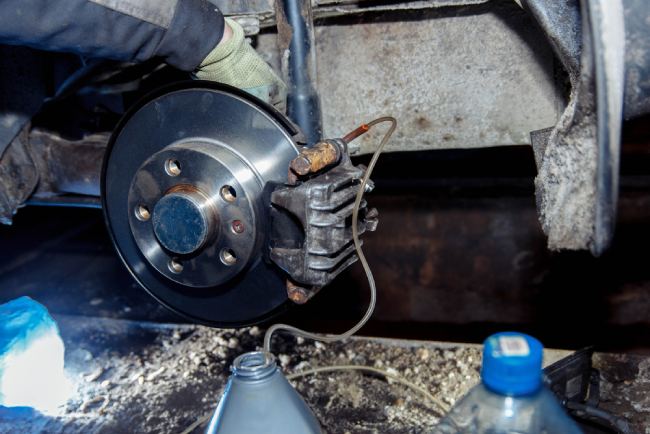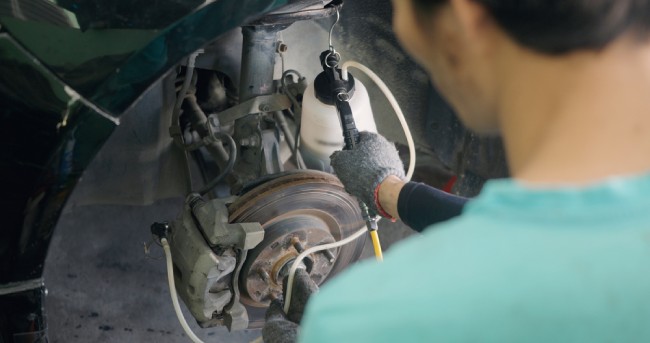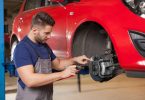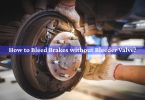There should never be air in your brake system, but sometimes bleeding the brakes doesn’t go as planned.
Here we will look at 14 reasons why the brake fluid won’t come out while bleeding, offer solutions, and share five techniques to bleed your brakes.
Why Is No Brake Fluid Coming Out When I Bleed My Brakes?

You will need someone else to help you no matter which technique you use. Brake bleeding is a two-person job!
Reason 1: Proportional valve issues
Only your back brakes have proportional valves. So if you can’t get the rear brakes to bleed, it is probably an issue with the proportional valve.
Solution: Valve diagnosis
To check the proportional valve, you will need a sprayer with brake cleaner to get into the four-valve openings. Before starting, you will need to detach it from the system.
If the fluid does not go through all four valves, you will need to replace it.
Reason 2: Brake flex hose tears
The brake fluid goes through the flex hose and into the dynamic brake calipers. These hoses, over time, have exposure to the environment, which can rot and corrode the flex hose; creating a clog in the hose and leaking brake fluid. Once this happens, the brake fluid becomes contaminated.
Solution: Change the hose
Check the hoses for cracks and tears. Examine the inside and outside of the hoses for any leaking. To check for a clog/blockage, put pressure on the brake pedal and pump the brake fluid through the flex hose. Any bulging in the hosing is a blockage, and the hose will need replacing.
Reason 3: Blockage in Brake fluid line
I talked above about clogs and blockages in the line from the environment, but these can also be caused by using the wrong fluids and brake line inclusion.
Solution: Remove the blockage using a plunger, then refill the brake fluid
Whenever you are using brake fluid, check the owner’s manual and make sure you have the correct fluid for your car.
While pumping fluid into the hose in the above check, examine the brake lines for tears, bulges, and leaking. If you see any of these, you will need to replace the brake lines.
Reason 4: Can’t open ABS line
No fluid will get to the module as long as the lines are clogged.
Solution: Use the diagnostic computer
When your ABS light is on, there is a problem in the system you need to check. You can do this by using a diagnostic machine or manual check.
The diagnostic check is done through a mechanic, or if you have the machine, you can run it yourself. Some auto part stores have the machine and will do the diagnostic check free as long as you buy any parts you need from them.
Once you know what the problem is, you can fix it.
- Defective ABS pump
A defective ABS pump is a common issue. Unfortunately, the solution for this is to replace the pump. You can use a vacuum to suck out the line or a syringe to push brake fluid through the lines to clear the clog.
- Clogged ABS valves
You can clear the valves the same way you cleaned the lines, using the vacuum and an attachment or using the syringe and pulling up on the plunger to pull the debris out.
Reason 5: Bleed screw issue
You turn the bleed screws to open the lines on the brakes. Unfortunately, they are put in a spot that sees much weather and the heat off the calipers. As with any other part, this exposure causes it to corrode, leak, rust, and clog. The bleed screws are on the outside of the caliper’s fluid chamber.
Solution: Look for blockage, leak, or corrosion
Check your bleed crews for rust, corrosion, and leaks. If you find these, you will need to replace them too.
Reason 6: Caliper build-up
After checking the proportional valve, if you still don’t get fluid when bleeding the rear brakes, you need to remove the rubber hoses on the calipers.
Solution: Take off the rubber hoses
Then, leave the proportional valve without the fluid fully open while you pump the brakes to see if the fluid escapes.
Now remove the rubber hoses and look for fluid inside. If there is none, the caliper has build-up.
Reason 7: Dirty brake fluid
You can not flush the calipers if there is a build-up of pressure. The cause of the pressure is contaminated brake fluid.
Solution: Flush out the caliper
The only solution is the flush out the calipers.
Reason 8: Lower halves of the bores are cruddy and corroded
Vibrations and noise from your brakes come from brake drums and discs corrosion. When this continues, your brakes will eventually not stop correctly, and there will be incredible damage to your brake pads and discs. It will also eat away at the bores and brake lines.
Solution: Replace them
Look for leaks and corroded areas and replace these parts immediately.
Reason 9: Valve bleeder issues
It takes an immense amount of pump pressure to get the air to operate the valve before you see them bleed.
Solution: Open the bleeder on each pumping cycle and reclose them
You will have to keep pumping the brake and opening and closing the bleeder until they start to bleed
Reason 10: The caliper is not in the proper position
Sometimes the caliper’s position is wrong, or the torque is off.
Solution: Correct the caliper
You will need to replace the caliper and torque it correctly.
Reason 11: You loosened a chunk of crude
Somewhere there was a clog, and you worked it loose.
Solution: Clean the clog
Since you don’t know where the clog is, you need to start at the axel’s T or axel to the flex line and work backward. You need to remove it or replace the whole part.
Reason 12: Break fluid is low grade
Using poor-quality or contaminated brake fluid keeps the brake pads from applying pressure to the rotors and letting them bleed.
Solution: Change the brake fluid
You can fix it quickly by changing the brake fluid.
Reason 13: Frozen or busted calipers
Busted and frozen calipers won’t bleed because they can’t clamp down on the pads effectively.
Solution: Replace calipers
You will have to replace your calipers in this case.
Reason 14: Fluid doesn’t empty from the master cylinder
The master cylinder supplies the caliper pressure. If there’s no pressure, there are no brakes.
Solution: Replace the brake system
You can deal with this in two ways: take the master cylinder apart, replace the seals, refill it with fluid, or replace the master cylinder.
How to Bleed Brakes: Best Methods!

Method 1: Reverse technique
Tools
- Screwdriver
- Rags
- Clean Brake fluid
- Pump
Step 1: Push the fluid through the bleeder valve and into the master cylinder using the pump.
Step 2: As you pump, look for the brake fluid to come out of the brakes as the air rises.
Method 2: Pumping and holding technique
Tools
- An Assistant
- Rags
- Fresh brake fluid
Step 1: Have your assistant hold down the brake pedal.
Step 2: While the pedal is depressed, open your first bleed screw and let the air out.
Step 3: Repeat steps one and two.
Method 3: Vacuum technique
Tools
- Vacuum pump
- Rags
- Brake fluid
Step 1: Connect the vacuum pump to the bleeder valve.
Step 2: Open and close the pump to pull out the brake fluid.
Step 3: Continue repeating step #2 until you have all the air and bubbles out.
Method 4: Gravity technique
Tools
- Brake fluid
- Rags
Step 1: Locate the bleeder valve below the reservoir.
Step 2: Open the valve and let gravity drain the brake fluid.
Step 3: Drain the valve till the air is out.
Method 5: Pressure Technique
Tools
- Pressure pump
- Rags
- Fresh brake fluid
Step 1: Connect the pressure pump to the master cylinder.
Step 2: Pressurize the system and open the first valve allowing it to drain.
Step 3: Repeat step #2 on all other valves.
FAQs
1. Can I mix old and new brake fluid?
Ans. No. Brake fluid absorbs water and is then contaminated. You should replace all the fluid in the brake system at least every two years. After that, be sure you use the correct brake fluid for your vehicle.
2. Can I change brake fluid without bleeding?
Ans. No, the only way to remove the air from the system is to open the bleeding screws and add new brake fluid until you see the new fluid exiting the bleed screw.










Leave a Comment